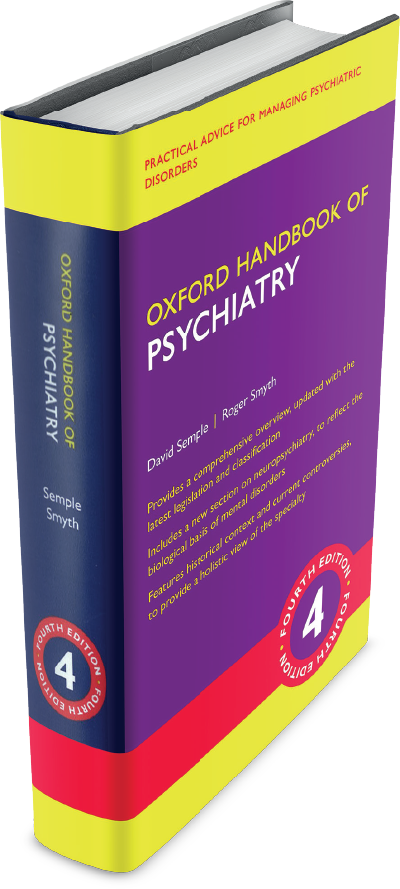The Oxford Handbook of Psychiatry embodies all major psychiatric disorders, focusing on psychiatric subspecialties and thus providing an overview, created from a practical and comprehensive perspective of addressing mental disorders, their psychopathology, evidence-based practice, the problems they raise regarding therapy and psychotherapy, or when it comes to cross-cultural psychiatry. This handbook was updated in December 2015, in order to reflect the new trends in the field.
The book was published in February 2013 in edited format and in March 2013 appeared in online format at the Oxford University Press, UK. In 2014, it was awarded the BMA Book Awards, having a favorable reception and numerous reviews and comments that support its usefulness and importance in the field.
The authors of the book are David Semple, psychiatrist consultant at the Hairmyres University Hospital and honorary member of the Psychiatry Division of the University of Edinburgh, UK, and Roger Smith, psychiatrist consultant in the Department of Medical Psychology at the Royal Infirmary of Edinburgh and Honorary Clinical Senior Lecturer at the University of Edinburgh.
The acknowledgement section cites all the co-authors who contributed to the creation of the chapters of this handbook. This book has reached its fourth edition, marking a new beginning, including all the updates provided by the most current version of the classification launched by the American Psychiatric Association, DSM-5. The entire text of the previous edition has been revised, in order to reorient the content to mark the evolution of ideas that directly and indirectly influence psychiatric thinking. This directive includes notions of global mental health and gender issues. At the same time, taking into account the newly found knowledge regarding the biological mechanisms underlying the mental disorders, the handbook is provided with a new section of neuropsychiatry, with a new conceptual definition of what neuropsychiatry really represents.
The authors made this update to the Oxford Handbook of Psychiatry to encourage scientific thinking with holistic tendencies, taking into account the wide range of areas that influence the current practice of psychiatrists, such as philosophy, ethics, sociology and forensic issues.
The handbook has 1147 pages and is divided into 26 chapters, covering all areas of interest in contemporary psychiatry, starting from a chapter aimed at the conceptual framework of psychiatry with a review of scientific guidelines, the role of the psychiatrist, myths related to the psychiatric disease, stigma and the notion of mental disorder, continuing with a section dedicated to psychiatric evaluation and one that essentially refers to the fundamental basics of psychiatric semiology, then moves on to a chapter of neuropsychiatry to then be presented, in a clear and systematic way, the main mental disorders (schizophrenia and other psychotic disorders, depressive disorders, bipolar disorders, anxiety spectrum disorders, eating and impulse control disorders, sleep disorders, reproductive psychiatry, personality disorders, gerontopsychiatry, disorders related to psychoactive substance use, mental disorders of the child and adolescent), followed by a chapter dedicated to forensic psychiatry, one related to intellectual disability, another on liaison psychiatry, a section on various aspects and notions of psychotherapy, and sections on legal issues in psychiatric medical practice, cross-cultural psychiatry, therapeutic approaches, major psychiatric emergencies, useful resources and an index reported to ICD-10 and DSM-5. In addition, right at the beginning of the book, we find a section of symbols and abbreviations.
The first chapter, Thinking about psychiatry, is prefigured as an introductory section, as an exhaustive description of the place of mental illness, psychiatrist and psychiatry in the medical world, with subchapters on disease definition, psychiatric diagnosis, perception of psychiatry, psychomitology, stigma, antipsychiatry and a very short but conclusive section on the history of psychiatry. In addition, the first chapter addresses some issues related to the current practice of the psychiatrist and the nature and effects of his work: Why do psychiatrists look at the brain ?, Can psychotherapy change the brain ?, The power of placebo, Treating patients against their will.
The second chapter, entitled Psychiatric assessment, manages to create a clear, detailed and concise picture of what the psychiatric interview means, starting from describing the interview preparation, how to manage the dialogue with a psychiatric patient, some tricks regarding obtaining anamnestic data, with fundamental details from the patient’s personal and family history, up to the examination on mental functions of the patient’s mental state. In addition, the chapter is provided with a section on summarizing the case, including the most important elements of the patient’s personal and medical history, the psychiatric examination itself, suicide risk assessment and disease insight, followed by differential diagnostic algorithms, the approach of the case according to predisposing, precipitating and perpetuating factors and the management plan, taking into account all the information previously described.
The third chapter, Symptoms of psychiatric illness, contains a very brief overview of psychiatric symptoms, followed by a section entitled Dictionary of psychiatric symptoms, which explains clearly and synthetically the main semiological notions of psychiatry, but also a series of terms that refer to adverse effects of psychotropic medication, thus foreshadowing an instrument of work in itself through the clarity and eloquence of the description and explanation of these notions.
The fourth chapter, Neuropsychiatry, focuses on the role of neurological examination, on the organic implications of neurological factors in the pathogenesis of mental disorders, on neurodevelopmental features, neuropsychiatric peculiarities in epilepsy, nonvascular dementia, prion infection, HIV infection, autoimmune diseases and psychiatric complications following strokes.
Chapters five consists of twelve major psychiatric diagnoses, starting with Schizophrenia and related psychoses, Depressive illness, Bipolar illness and up to Anxiety and stress-related disorders, Eating and impulse-control disorders, Sleep-wake disorders, Reproductive psychiatry, sexual health and gender related issues and Personality disorders. They are organized and synthetic, containing fundamental information for the recognition, diagnosis and therapeutic approach of each mental disorder, with various information related to the research history in a certain area of psychiatric pathology, but also historical landmarks of the disorder, epidemiology and, last but not least, pathogenesis. The positive diagnosis relates to both ICD 10 and DSM-5 criteria. In addition, the chapters are provided with descriptions of the clinical features of each mental disorder, described in detail and related to the practical intervention of the specialist. Psychopharmacological therapy is presented in accordance with the international guidelines, but does not omit the off-label recommendations, offering therapeutic switch strategies, as well as options for initiating psychotropic therapy.

The thirteenth chapter, entitled Old age psychiatry, provides a synthetic picture of the psychopathology of the elderly, including the issue of overspecialization in old age psychiatry. In addition, beyond the clinical aspects and the psychopharmacological approach, we find a related section of various legal issues interconnected with this area of expertise.
The fourteenth chapter, Substance misuse, focuses on information on the clinical aspects and therapy of mental disorders resulting from the abusive use of psychoactive substances, starting with a definition of the addiction syndrome. Thus, the substances to which the chapter refers are alcohol, tobacco and illicit drugs such as opioids, stimulants, hallucinogens, volatile substances etc., introducing the notion of legal highs.
The fifteenth chapter, Child and adolescent psychiatry, includes clinical-therapeutic notions related to mental disorders characteristic of childhood and adolescence, with particularization of the approach to psychopharmacological therapy, but also family psychotherapy.
Forensic psychiatry, the sixteenth chapter, details a series of aspects related to forensic psychiatry, with legislative references and methods for assessing the risk of aggression, detailing the correlation between crime and mental disorder and describing the most secure medical units.
The seventeenth chapter refers to Intellectual disability, providing a holistic picture on this subject, detailing the etiology, highlighting the clinical circumstances most commonly associated with intellectual disability, and highlighting the benchmarks of therapeutic management and management of family problems or even medico-legal implications.
Liaison psychiatry, the eighteenth chapter, aims at the clinical-therapeutic approach of concourrent or comorbid psychiatric syndromes with somatic disorders.
The next chapter, the nineteenth, Psychotherapy, offers both a historical perspective on psychotherapy and a series of indications and actual psychotherapeutic orientations and techniques, defining the fundamental role, both therapeutic and especially focused on social reintegration and increasing the patient’s quality of life.
The twentieth chapter, Legal issues, refers to legislative particularities aimed at mental health, specific to the UK.
Chapter twenty-one is dedicated to Transcultural Psychiatry, and the next one, twenty-second, deals with Therapeutic issues, focused on the idea of therapeutic adherence, the side effects of psychotropic medication and a series of particular clinical conditions that impose adjustments or restrictions on the administration of psychotropic drugs.
The twenty-third chapter, Difficult and urgent situations, essentially refers to the management of major psychiatric emergencies, with an original final section, dealing with a subject often overlooked, the mental health of doctors.
Chapter 24 includes useful resources, addresses, e-mails, contact phone numbers, useful to patients suffering from various mental disorders.
The 25th chapter includes an ICD-10/DSM-5 index, useful in systematizing and providing an operational meaning to the diagnostic criteria, followed by an alphabetical index with corresponding reference of the pages where the terms can be found.
Oxford Handbook of Psychiatry is an extremely focused and clear clinical-therapeutic guidance tool, which has the schematic aspect of a real guide, clarifying the issue of positive and differential diagnosis, as well as classical and off-label therapeutic approaches, with association strategies, switch and increasing doses of psychotropic medication. However, it does not neglect the forensic and social aspects, inextricably linked to psychiatric practice, including a series of operative notions of psychiatry. The logical and schematic aspect of the book, the succession of the chapters, the ample thematic treated and the practical illustration of some situations make this book an indispensable tool for young psychiatrists and an absolutely necessary instrument for the experienced practitioners.
